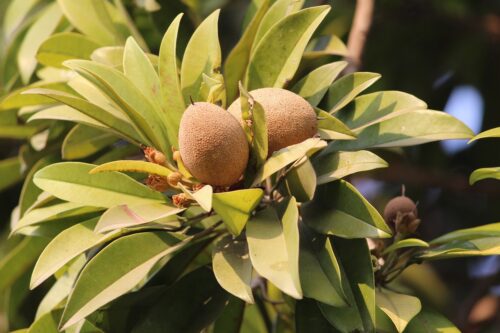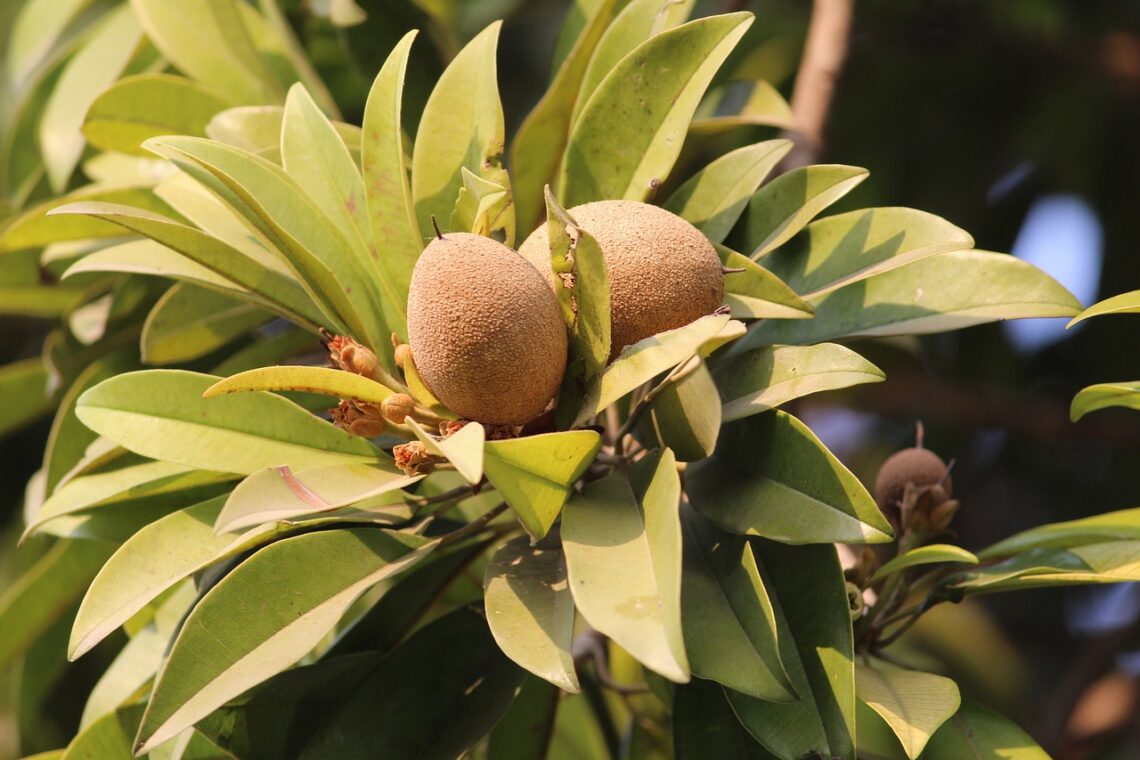Nasberry or Chiku trees are self-fertile and can be planted in containers easily. This guide will teach you how to Grow Sapodilla in Pots.
Sapodilla is an evergreen, tropical plant now grown in many countries across the globe for exports and fruit consumption. You can grow this tree in a pot and outdoors in the garden. Plant this exotic fruit plant to enjoy the sweet fruits by following our guide on How to Grow Sapodilla in Pots.
Botanical Name: Manilkara zapota
Common Names: Naseberry, chikoo, chiku, dilly
USDA Zone: 4-11
Sapodilla Plant Information

Sapodilla is also called Chikoo, Naseberry, Sapota, and Nispera. It is a long-living and slow-growing evergreen plant from Central America and Mexico. Primarily, the tree is grown in Asia.
When growing in the wild, it can grow up to be 80-100 feet tall; when grown indoors, it can grow up to be 8-10 feet in containers and 20-60 feet outdoors.
It features bell-shaped flowers and bears oval to elliptic-shaped, dark green leaves.
The trunk produces tough bark filled with white latex called Chicle. The plant bears grainy, juicy berries with 1-6 black seeds.
The fruit has a malty and sweet taste and contains vitamins C, A, copper, iron, folate, and potassium.
You can quickly propagate a sapodilla tee via viable seeds for many years. Remember that the plant takes 5-8 years to become a fruit-bearing tree.
The long-living, evergreen trees take a lot of time to grow and, after 30-50 years, can reach up to 60-100 feet tall when growing outdoors. The plant can adapt well to tropical and subtropical climates.
Propagating Sapodilla in Pots
Propagate Sapodilla using seeds easily, but have patience as it can take 6-9 years to start producing fruits.
The best time to grow Sapodilla is during late summer and early fall. It can thrive well in both humid and dry growing conditions.
Sow 1-3 seeds in a container with a good-quality soil mix.
Follow these steps:
- Dig up a deep hole in the container at the center.
- Sow the sapodilla seeds directly into the soil.
- Remember to use well-draining, good-quality soil to grow Sapodilla.
- Place the container in a spot that enjoys at least 6-8 hours of bright, indirect sunlight, including 1-2 hours of morning, direct sunlight.
- Push the seeds about 0.5-1 inches deep and water deep into the soil.
- It will take 1-3 weeks for the seeds to germinate. Then, you will have to wait 5-9 years for the plant to produce sweet fruits.
Choosing the Best Sapodilla Varieties for Growing in Pots
1. Silas Woods
This is a dwarf cultivar that you can quickly grow at home. The cold-tolerant and best-for container variety can be maintained at the height of 4-5 feet indoors.
2. Hasya
This is a Central American type of Sapodilla that produces yellow-red colored fruits in the shape of a football with just 1-3 seeds.
3. Morena
As the name indicates, it is a Mexican type that can grow up to 4-5 feet in pots. It bears hard fruits with an exceptional flavor and half caramel, half red shade.
4. Molix
Another Mexican variety can grow up to be 3-4 feet tall. With delightful fruits in red, it tastes most delicious when eaten fresh as it is. The pulp is often used to make milkshakes, sherbets, and ice creams.
5. Tikal
This Central American cultivar can be maintained at 2-3 feet height in pots. It produces small, fine-textured, elongated fruits.
6. Makok
Makok is another good choice for Sapodilla that you can grow in a container. It bears fruits with a sweet scent and smooth brown-colored flesh.
Selecting the Right Pots for Sapodilla
When you grow a dwarf kind, you should choose a 30-60 gallon container when it reaches maturity. However, in the beginning, if you select a two-size big planter than the rootball, it will work best for the plant.
Any glazed container requires a lesser amount of water as compared to unglazed terracotta pots. It is because of its porous nature. Choose a pot 18-24 inches in diameter and 20-24 inches tall with enough holes at the bottom.
Ideal Growing Conditions for Planting Sapodilla in Pots
Location
Choose a site with plenty of bright but indirect sunlight for the plant’s best growth. Remember to place the container in a spot where it can grow alone and not have to compete for sunlight.
Soil
Fill the container using well-draining, airy soil rich in organic content. Ensure that the soil’s pH level is between 6-8. If you use soil from your garden outdoors, do not forget to mix perlite and sand in equal amounts.
To make a potting mix at home, add bark, sand, vermiculite or perlite, and peat moss with organic compost in equal parts. The tree thrives very well in soil that is rich in calcium.
Water
You may have to water the plant every alternate day for the first 10-15 days. Then, reduce it to twice a week after 1-2 months for the next 5-6 months. After the tree is established and becomes 4-5 years old, it will not require such frequent watering.
Temperature
Growing Sapodilla is not rigidly tropical, and even adult plants can work in a temperature range of 26-28°F or -2- -3°C for a short duration.
Young plants can face severe damage or even be killed at 30°F or -1°C. The ideal range for growing this plant in a container is 70-95°F or 22-35°C.
Humidity
A relative 60-70 percent humidity is best for growing Sapodillas in containers. Increase the level at home by installing a humidifier next to the plant.
Alternatively, you can try plant grouping or use a pebble tray.
Sapodilla Care in Pots
Fertilizer
Use an all-purpose fertilizer with an NPK ratio equal to 5:5:5 once every 50-70 days in the first year. Read and follow all the instructions mentioned on the label, and it will be sufficient to provide all the necessary nutrients.
Pruning
Prune the crown if you notice younger plants starting to look leggy with fewer branches at the bottom. It will promote new growth, and as the tree matures, you will need to trim out dying, decayed, old, diseased parts. Never cut out the branches on the lower part of the plant. Maintain the height to about 4-6 feet in containers.
Mulching
Mulching can help the plant retain moisture for longer and save the roots from freezing temperatures. Use a 3-6 inches thick layer of wood chips or bark to mulch your young plants. Once the plant matures, place the mulch 8-15 inches away from the bark.
Pest and Diseases
Keep an eye open for green shield scale, Caribbean fruit fly, pustule scale, leafminer, and Cuban may beetle. Use insecticidal soap or neem oil to drive these pests away, or consult an expert.
Also, watch out for any symptoms of leaf rust. Use an organic fungicide to treat the infection.
Harvesting and Storage
Be patient enough to let the plant start dropping plants. Start harvesting the ones that are of similar size. Also, you can check the skin color of the fruits to know if they are ready to harvest. Once the color changes from brown to amber, you should know they are ready.
Alternatively, you can also scratch the skin lightly to check if it is tan in color and if the fruits have ripened. However, if it oozes latex or is green, you should know it is still not ripe.
Store the fruits in the fridge for 8-12 days.



